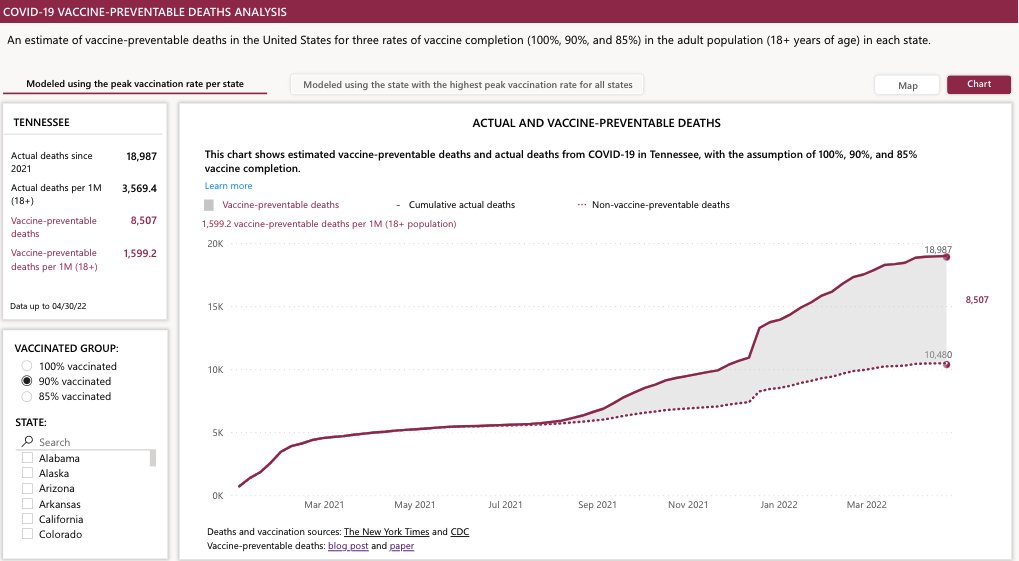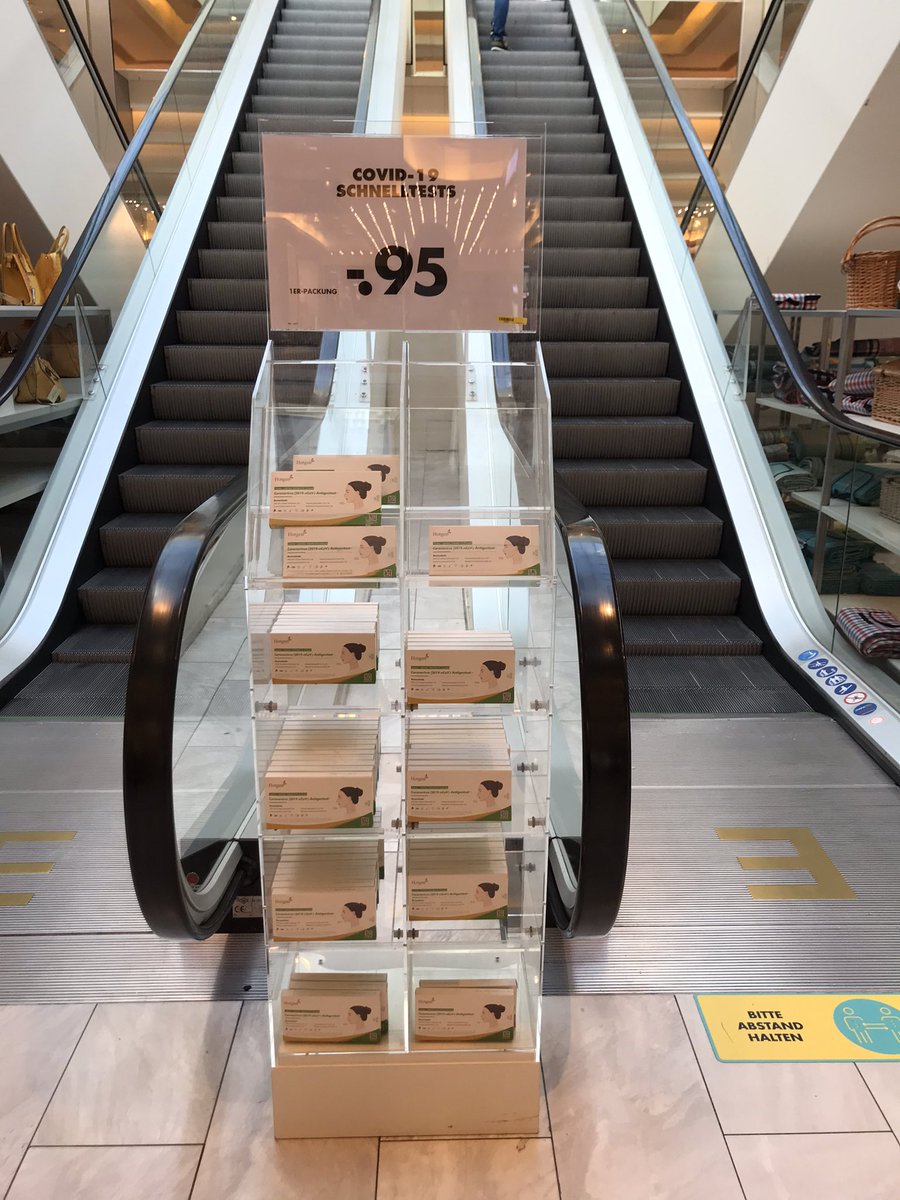
As we mark 1 mill. Covid deaths this weekend, we launched a new dashboard that delivers a hard truth: about every second person who died from Covid-19 since vaccines became available could have been saved by – yes, vaccines. A 🧵about data, people & trust
npr.org/sections/healt…
npr.org/sections/healt…
First, the data. Here is what we did: Let’s say you live in Tennessee. At some point in April 2021, people were no longer competing to get Covid shots in your state – supply outstripped demand.
But what if people had kept coming? /2
But what if people had kept coming? /2
What if Tennessee had continued to vaccinate at that peak pace, until everyone 18 years and older had a shot? And then, starting in October 2021, people had started to get boosted if their last shot had been more than 6 months ago? Looking at this WHAT IF? scenario is sobering /3
Roughly 640,000 people have died from Covid in the U.S. between Jan.1, 2021 and April 30, 2022. Our scenario shows that at least 318,000 of them could have been saved by vaccines
In Tennessee, over 18k died from Covid. About 11k of those could have been saved by vaccines /4

In Tennessee, over 18k died from Covid. About 11k of those could have been saved by vaccines /4


But a 100% vaccination rate is not possible, you say?
Sure. Let’s look at a 90% vaccination rate.
That’s still over 225,000 lives that could have been saved by vaccines nationwide. And over 8000 lives lost prematurely in Tennessee. /5

Sure. Let’s look at a 90% vaccination rate.
That’s still over 225,000 lives that could have been saved by vaccines nationwide. And over 8000 lives lost prematurely in Tennessee. /5


No matter how we adjust the levers – and you can adjust the levers on our dashboard to look at different scenarios – the incomprehensible truth is this: So many people didn’t have to die. So many people could still be with us. /6
globalepidemics.org/2022/05/13/new…
globalepidemics.org/2022/05/13/new…
Of all the countries in the world, regardless of available resources, the U.S. has the 2nd highest Covid death rate per capita after Mexico.
The U.S. also had effective vaccines the earliest.
We should have one of the lowest death rates.
We don’t. /7
coronavirus.jhu.edu/data/mortality
The U.S. also had effective vaccines the earliest.
We should have one of the lowest death rates.
We don’t. /7
coronavirus.jhu.edu/data/mortality
Sadly, because of the enormous death toll, we have a lot of real world data. We know who has been dying from Covid since vaccines became widespread. It’s overwhelmingly unvaccinated and under-vaccinated Americans. These losses are beyond heartbreaking /8
covid.cdc.gov/covid-data-tra…
covid.cdc.gov/covid-data-tra…
Because all of this is about people. Mothers, fathers, children, grandparents, sisters, brothers, husbands, wives, colleagues, friends...
Each of them leaving a hole in the lives of countless others. /9
Each of them leaving a hole in the lives of countless others. /9
https://twitter.com/rowlanddeborah1/status/1522361339397648384?s=20&t=CiFZwShQIu7T8KjDIBVv3w
We haven’t even begun to fathom the collective trauma that has settled in our midst.
Just take a moment to read through some of the responses to @choo_ek ‘s kind tweet, making space for shared memories and grieving. /10
Just take a moment to read through some of the responses to @choo_ek ‘s kind tweet, making space for shared memories and grieving. /10
https://twitter.com/choo_ek/status/1522213081694150656?s=20&t=CiFZwShQIu7T8KjDIBVv3w
One story at a time, told in the voice of survivors, we see the U.S. pandemic for what it is. Not just another game of politics. Not some abstract numbers. Not the greatest threat to our economy.
Rather, a new chapter in This Republic Of Suffering. /11
npr.org/templates/stor…
Rather, a new chapter in This Republic Of Suffering. /11
npr.org/templates/stor…
For we are embarking on a new relationship with death. /12
https://twitter.com/nksperry/status/1522235905758703616?s=20&t=CiFZwShQIu7T8KjDIBVv3w
https://twitter.com/DrMarjorieRobe1/status/1522404878202585089?s=20&t=CiFZwShQIu7T8KjDIBVv3w
https://twitter.com/Vasq_Priscilla/status/1522407923049136129?s=20&t=CiFZwShQIu7T8KjDIBVv3w
https://twitter.com/lulu7534/status/1522418450173366273?s=20&t=CiFZwShQIu7T8KjDIBVv3w
Which brings us to the trust part.
How did we get to this point? Why are our models for delivering and building confidence in life-saving public health measures failing to reach and protect all Americans equally? /13
#VaccinesWork #VaccinesSaveLives
How did we get to this point? Why are our models for delivering and building confidence in life-saving public health measures failing to reach and protect all Americans equally? /13
#VaccinesWork #VaccinesSaveLives
In our research and work with communities, we find that unvaccinated Americans are not a monolith – but instead diverse individuals with unique histories, identities and lived experiences. /14
globalepidemics.org/2022/05/13/wha…
globalepidemics.org/2022/05/13/wha…
We find concerns about Covid-19 vaccines among people of all races and ethnicities, faith groups, education and income levels, and yes, political leanings and affinity groups — but not the same concerns. /15
We find people who have more questions, ask for more time or who feel alienated. For some Covid-19 is just one of many health threats and by far not the worst. Some are being misled. Some don’t believe that Covid-19 is real. /16
But unvaccinated Americans largely have one thing in common: they have historic distrust or have lost trust in authorities and institutions, and the information those are sharing. /17
That’s how in this pandemic, progressive and conservative opponents of vaccines suddenly find themselves united in the same conspiracy beliefs. /18
opendemocracy.net/en/countering-…
opendemocracy.net/en/countering-…
That’s how anti-vaxx misinformation pushed out by white folks succeeds in exploiting existing anxieties in Black folks that stem from systemic racism. /19
firstdraftnews.org/long-form-arti…
firstdraftnews.org/long-form-arti…
And it’s at the core of the disastrous cycle of politicization of vaccines for political gain:
/20
/20
People who don’t trust government → are being told lies about how gov is out to harm them → which intensifies distrust & incentivizes behavior in opposition to gov. guidance → results in worse health outcomes → further drives distrust in a system that’s not protecting you /21
In short, blaming unvaccinated and undervaccinated Americans for their choices is an utterly ineffective and costly strategy. Figuring out what builds trust, and how we can improve the trustworthiness of institutions, is an effective strategy. It’s a choice leaders can make. /22
Community leaders around the country are making this choice every day. They are as tired as everyone else yet ready to answer vaccine questions and bring shots closer to people every day. /23
bmorevaxxed.org
bmorevaxxed.org
The triumph of the U.S. vaccination rollout is not the sites delivering 1000s of vaccines a day – it's the 5 shots that went into arms after Sunday church. The shots brought into homes of those with disabilities. The shots delivered alongside a haircut /24
https://twitter.com/COVID19Black/status/1522591031996342275?s=20&t=iThFRYtOdDwQHOZN9JTkgQ
The tragedy of the vaccination rollout is the leaders who choose to minimize and denounce vaccinations. Political leaders need to be held accountable for the impact of their maneuvering on the people they are elected to serve. /25
vox.com/22947498/parti…
vox.com/22947498/parti…
Celebrities and influencers with large audiences need to be held accountable for the profit tactics that cost people their lives. /26
nytimes.com/2021/07/24/tec…
npr.org/2021/05/13/996…
nytimes.com/2021/07/24/tec…
npr.org/2021/05/13/996…
Foreign governments need to be held accountable for their disinformation campaigns that drive up distrust. /27
thehill.com/opinion/techno…
baltimoresun.com/opinion/op-ed/…
thehill.com/opinion/techno…
baltimoresun.com/opinion/op-ed/…
As devastating as it is to take in the numbers on the dashboard, they can help us turn the tide. Detailed data is available for every state. California and Florida are both larger states with larger deaths counts – but CA has half the vaccine preventable deaths compared to FL /28
How we talk about vaccines
who talks about vaccines
where we talk about vaccines
how we distribute vaccines
how we treat those who are not yet ready to receive a vaccine
how we support those who have more urgent risks than Covid
– all of these matter. /29
journals.plos.org/plosone/articl…
who talks about vaccines
where we talk about vaccines
how we distribute vaccines
how we treat those who are not yet ready to receive a vaccine
how we support those who have more urgent risks than Covid
– all of these matter. /29
journals.plos.org/plosone/articl…
There are no quick fixes. Effective approaches differ across geographies, identities and time. We need to invest. (Hello, members of congress!) Invest in infrastructures of trust to get people the protection from illness they deserve.
This challenge goes way past vaccines /30
This challenge goes way past vaccines /30
Last week, the New Hampshire senate approved a bill making ivermectin available through a standing order at pharmacies. Remember, ivermectin is ineffective against Covid but thanks to confusing early evidence & coordinated disinfo people think otherwise/31
wmur.com/article/senate…
wmur.com/article/senate…
We now have effective drugs against Covid (Paxlovid, Evusheld, Molnupiravir) but we struggle to communicate effectively about them, and to get them to people quickly and equitably.
Sound familiar? /31
khn.org/news/article/p…
Sound familiar? /31
khn.org/news/article/p…
Let's not keep repeating the same story. Our vaccine preventable death analysis shows what could have happened had we chosen a different future. Had leaders and institutions come together and made vaccines – not a big deal, just a tool that saves lives, accessible to all. /32
We can still choose this future.
A future with less death and trauma and tragedy.
A future with less judgment.
A future with more empathy. More accountability.
A future where we get closer to health equity.
Polarization is a man-made challenge.
Leadership matters.
/END
A future with less death and trauma and tragedy.
A future with less judgment.
A future with more empathy. More accountability.
A future where we get closer to health equity.
Polarization is a man-made challenge.
Leadership matters.
/END
• • •
Missing some Tweet in this thread? You can try to
force a refresh





